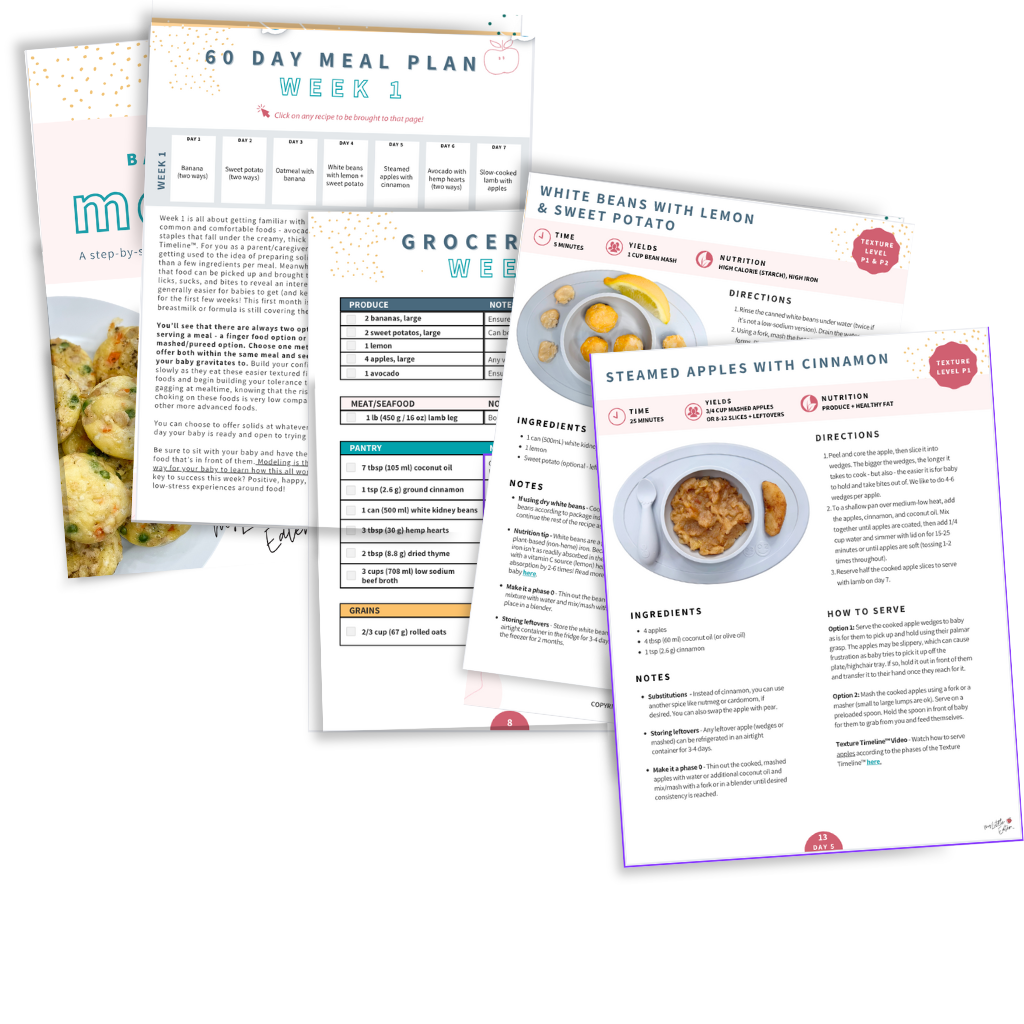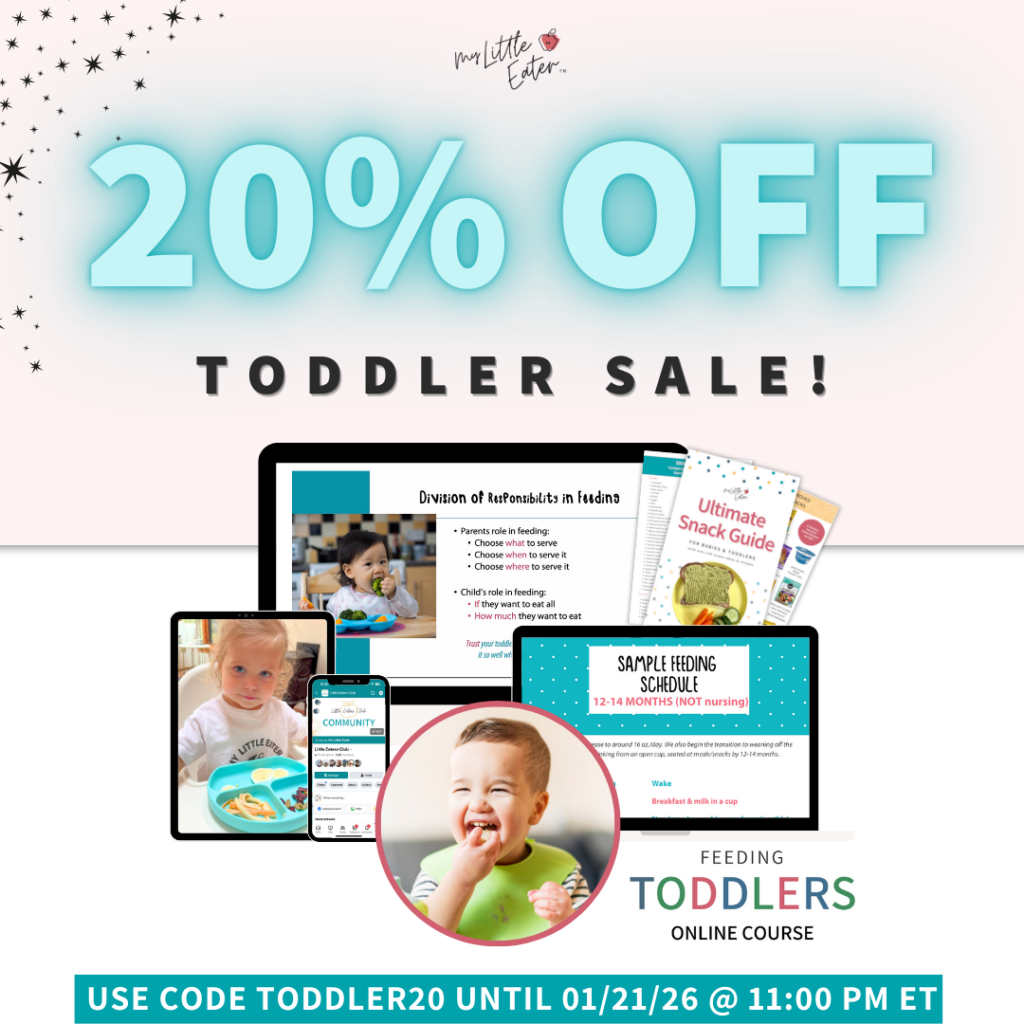You just got your baby’s milk and nap schedules figured out – when all of a sudden – they’re ready to start solid foods. So how do you now fit solids into their already seemingly complicated feeding schedule?
Balancing breast milk or formula feedings with solid foods and sleep can be hard to juggle because there are only 24 hours in a day, and ideally, we want to fit everything in during daytime hours. It’s also critical that they’re all spaced apart nicely.
That’s why we created sample feeding schedules for babies 6-12 months old so you can follow them and adapt them to your baby’s unique needs. They account for all the changes they’ll go through during this time, like dropping milk feedings and naps, and adding in more solid food meals.
Plus, we’ll show you how you can customize them to match your baby’s existing schedule, how to know they’re ready for more solids, and even give you tips for when they enter toddlerhood at 12 months old.
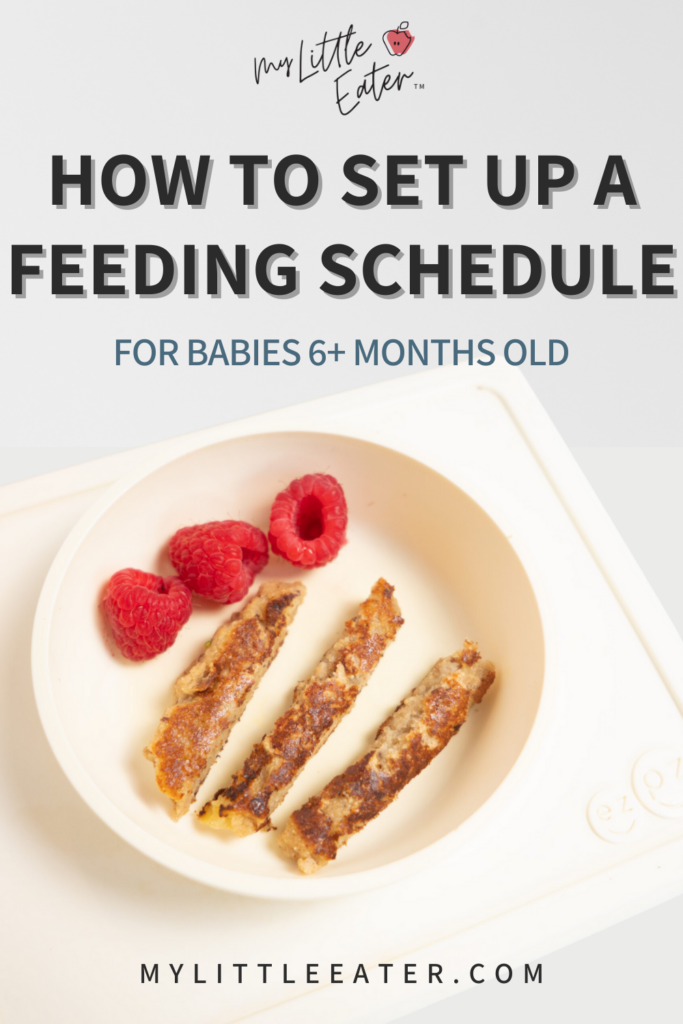
If you’re getting ready to start solids with your little one, you’re likely wondering how solid foods will impact your baby’s milk feeds. Don’t worry – you won’t be fully weaning yet, it’s more of a gradual process! But it can be a tricky transition and that’s why we created our breast and bottle weaning guide so you can feel prepared to enter this next stage of babyhood!
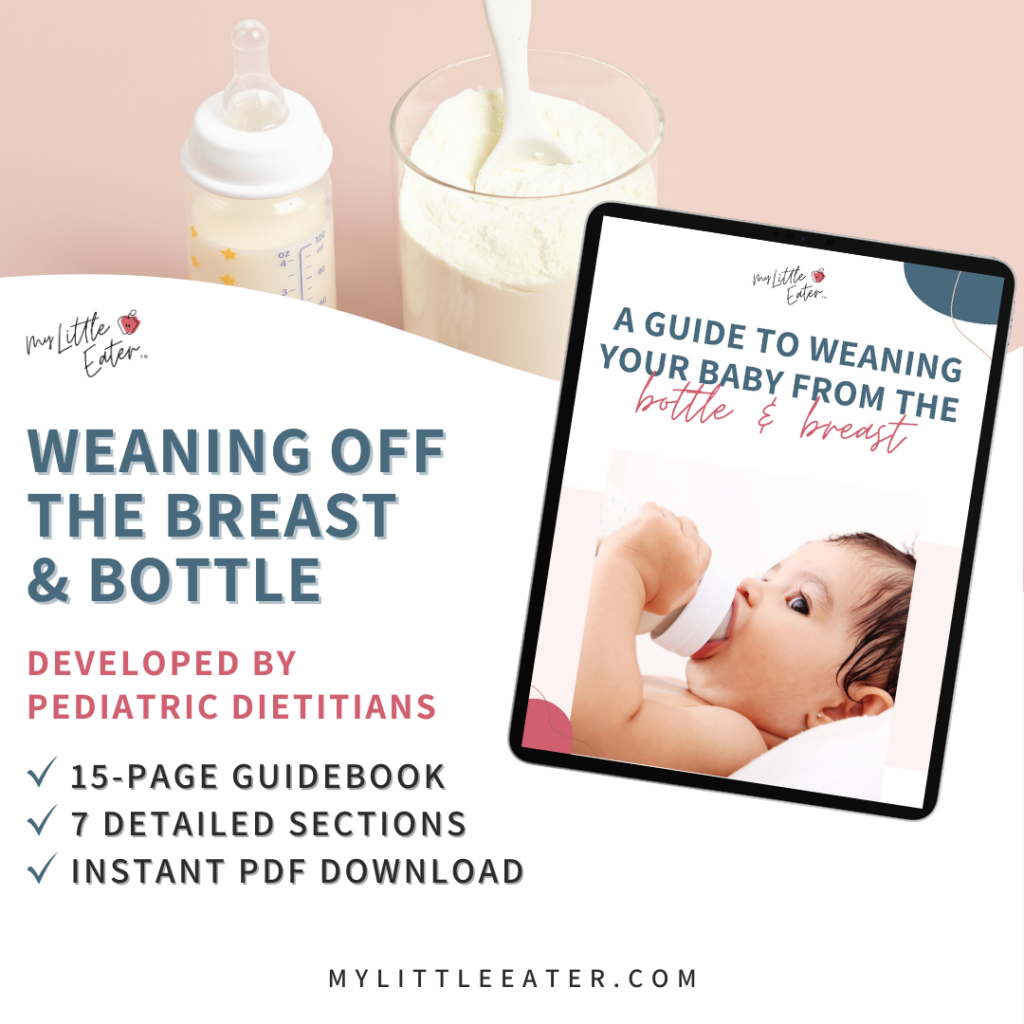
Table of Contents
If you prefer to listen while you multitask, check out our podcast episode below!
How often should you feed when starting solids?
Your baby will continue to add more meals and snacks as they get older, coinciding with a drop in milk feeds. Our goal is to have your baby eating 3 solid meals per day by 9 months old.
This is because we want to ensure they’re getting enough practice to develop their eating skills by 12 months old when food becomes their primary source of nutrition over milk.
Review the chart below to see how the number of meals changes with age, and grab our breast and bottle weaning guide for more guidance on how milk feeds will change over the months as well.
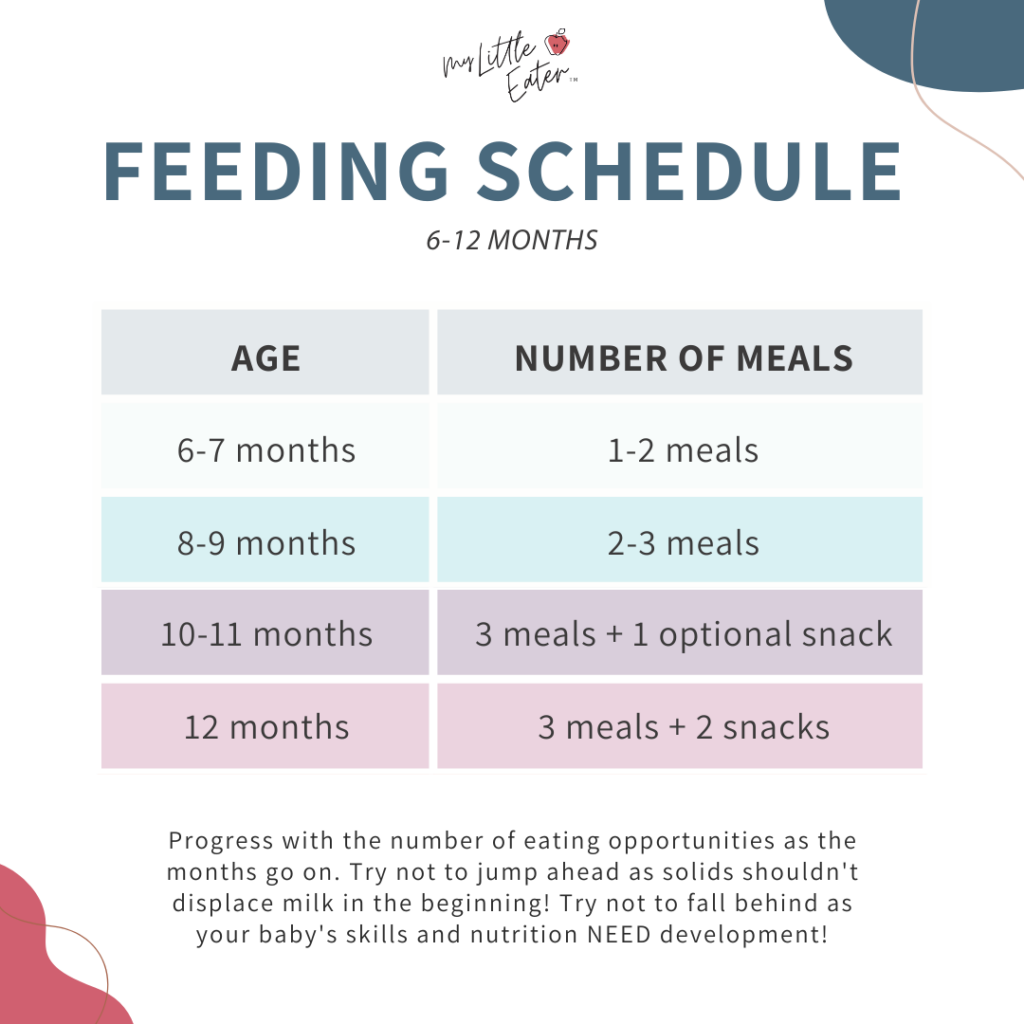
Sample feeding schedules from 6-12+ months
Your baby’s feeding schedule is dependent on their sleep schedule, how old they are, how often they nurse or take a bottle, and more. Making sure you fit everything into their busy little schedules can feel overwhelming and we totally get it!
Take a look at our sample feeding schedules below to guide you and help you get the basics down. Feel free to screenshot or pin whichever schedule fits your baby’s age so you can easily reference it!
6-7 months
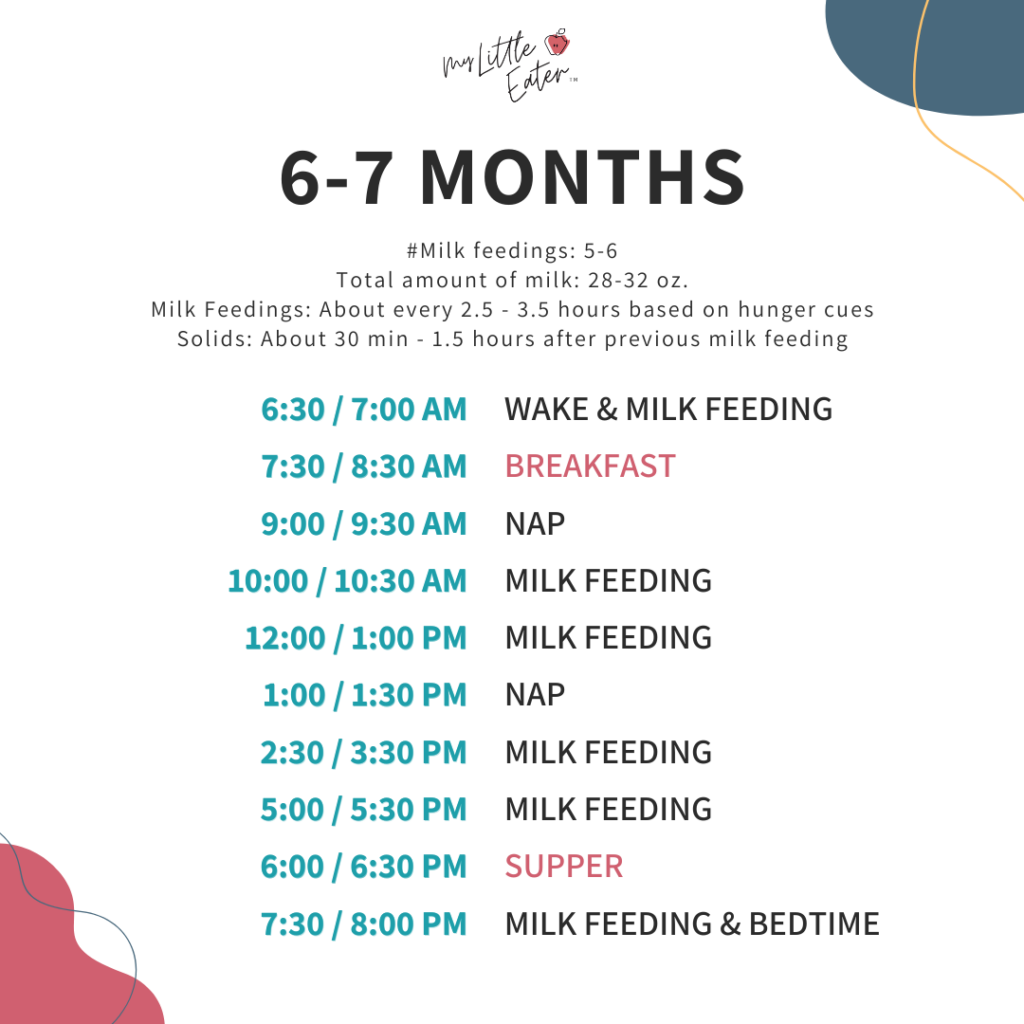
8-9 months
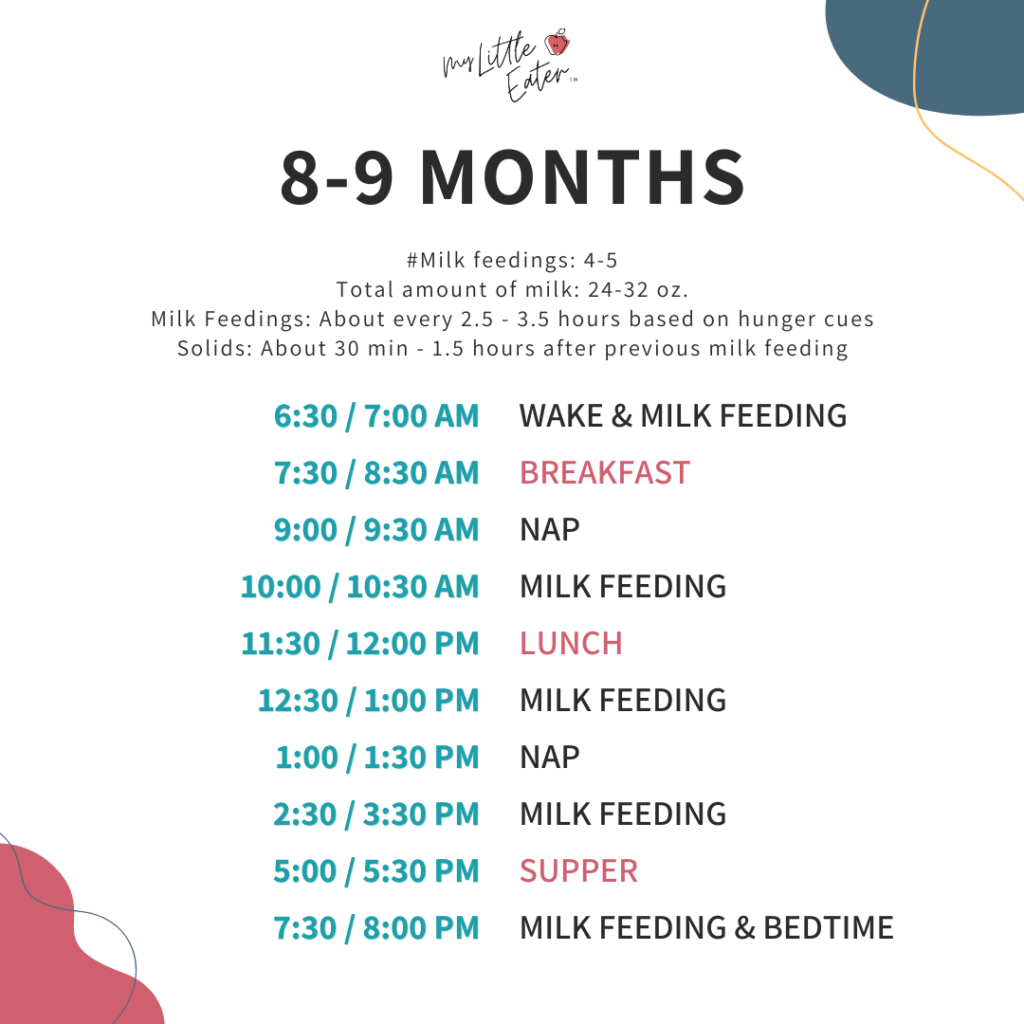
10-11 months
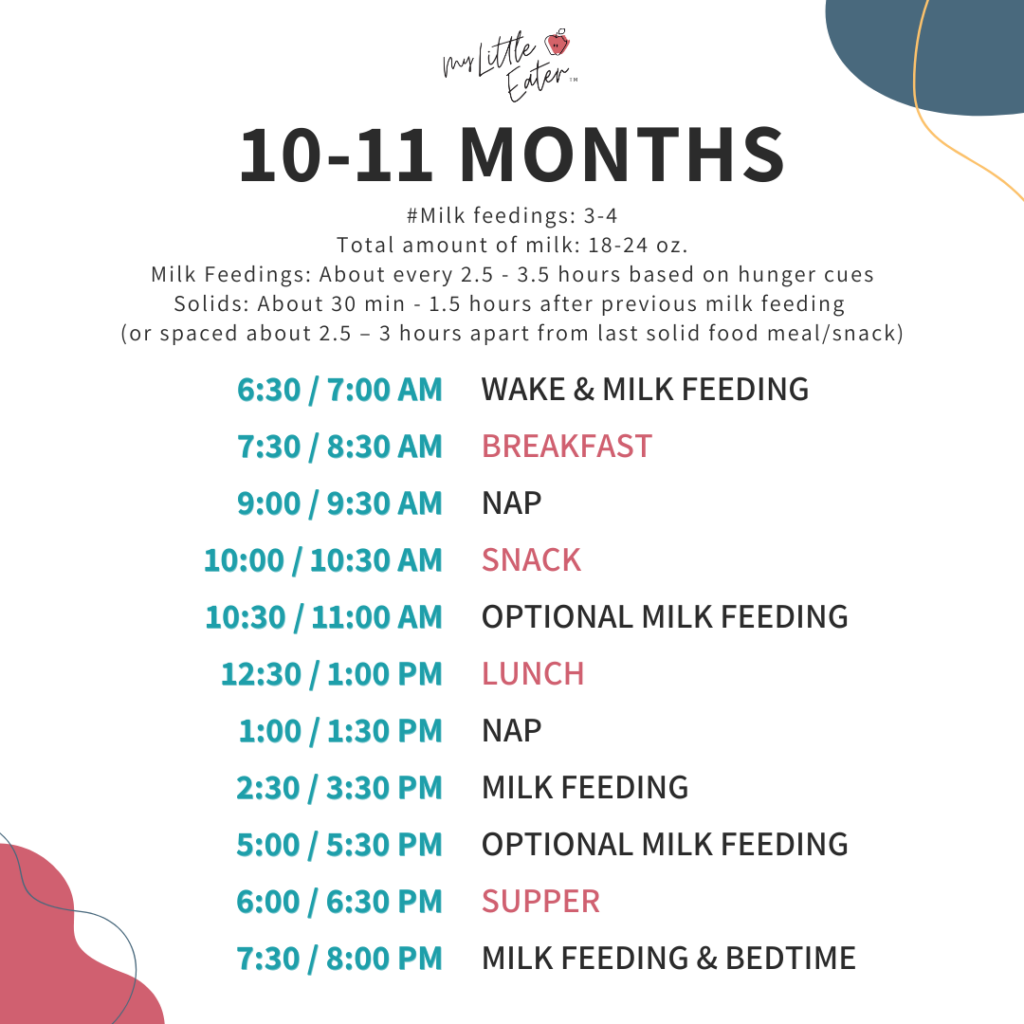
11-12 months
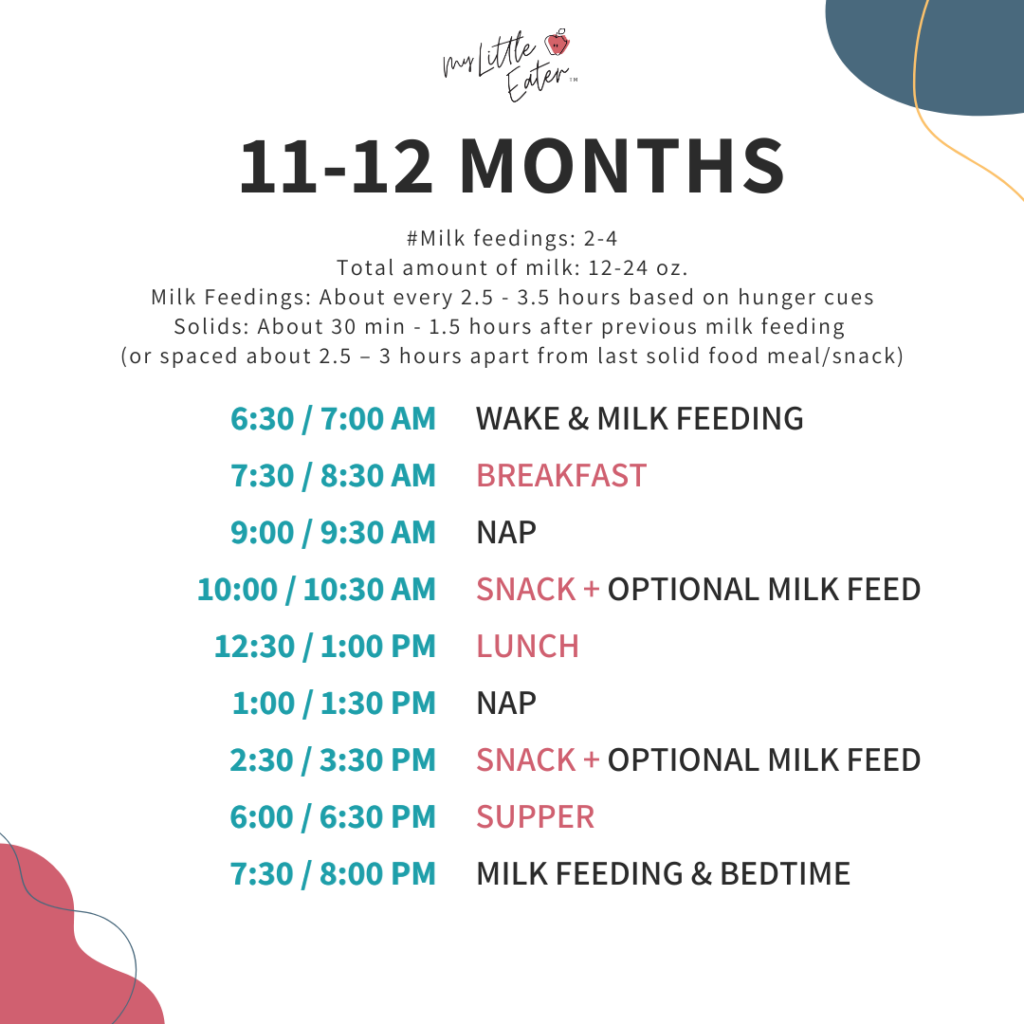
Length of solid food meals
Times listed in the samples above are suggested START times and are not an indication of the duration of a meal. That said – we don’t want these meals or snacks to last forever. Keep things moving along swiftly, or it will last so long that it interferes with the next feeding.
We recommend aiming for 5-30 minutes for a meal, with a maximum mealtime length of 45 minutes.
How to customize your baby's feeding schedule
Now that you have an idea of what your baby’s schedule could look like, let’s go over how to make this schedule work for you and your family’s unique needs.
First, we want to emphasize that these samples are guidelines and not rules you have to adhere to. We’re here to help you find what works for you, and we fully expect your baby’s schedule to vary slightly from these samples.
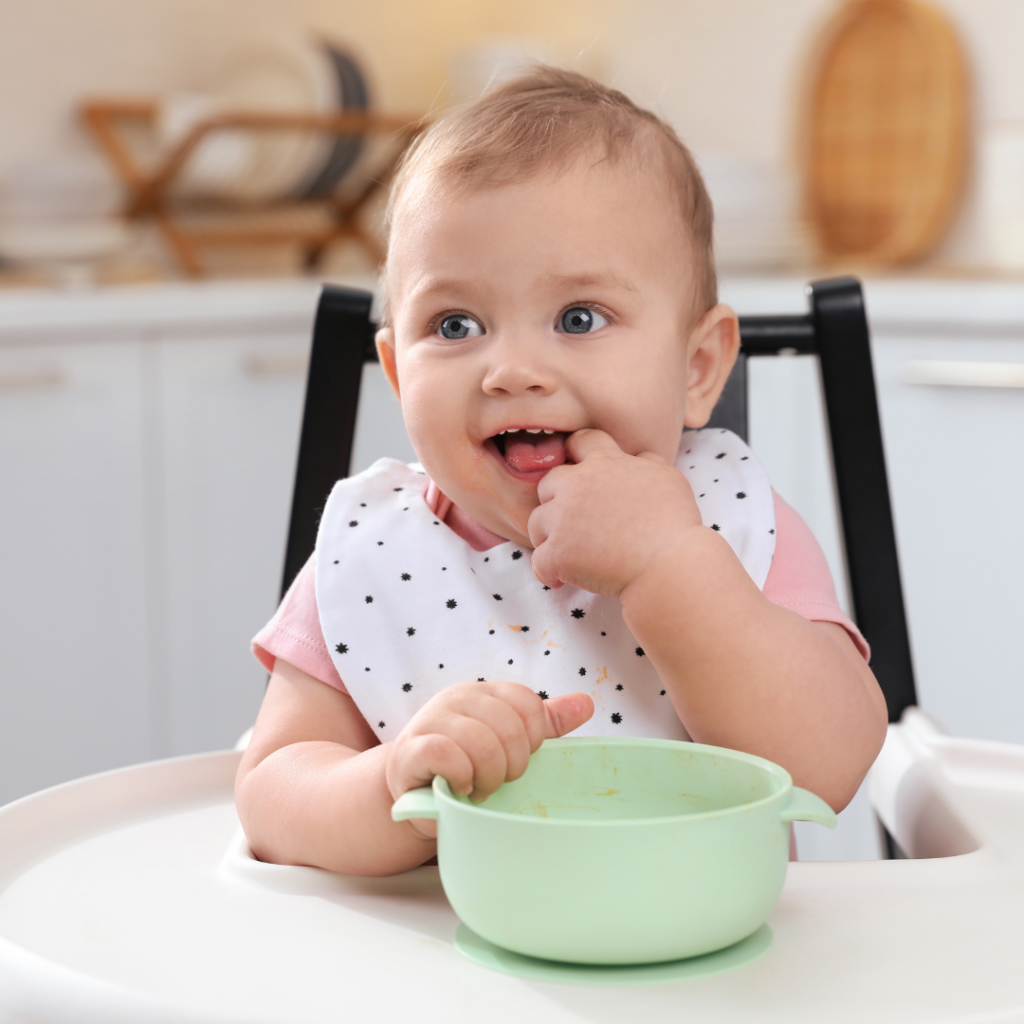
That being said, we have some tips to help create your custom schedule so that it’s ideal for your baby.
Your baby’s schedule needs to…
- Ensure your baby works up an appetite for solids
- Provide enough opportunities to drink breast milk or formula throughout the day (as this continues to be their main source of nutrition)
- Include buffer time to keep the schedule flexible and realistic to stay consistent
- Include naps!
To see this in action, with a realistic example of how to adjust to changing circumstances, follow along with our example first week of starting solids.
We also want to be clear that just because you have a flexible feeding schedule, that doesn’t mean you aren’t following hunger and fullness cues. You will still need to pay attention to and recognize these in order to know if you should move up or push back a solid food meal, or milk feeding, day-to-day.
Your baby’s hunger will vary – it can be affected by sleep, teething, growth spurts, etc. So paying attention to their cues is still important.

Be sure to review our blog post on feeding cues for babies so you know what to watch for and can respond accordingly. All in all, use your judgement and aim for consistency, when possible.
To build your baby’s custom schedule, start with our sample as a base. Now, think about their typical wake time. Is it often the same or does it vary? Insert their average wake time at the beginning of the sample feeding schedule, being sure to provide an hour range to allow for flexibility.
How much does their wake time vary from the samples? If for example, your baby wakes up one hour later than we have on the sample schedule, move everything back by an hour to find your baby’s meal and nap times. If they wake an hour earlier, move everything else ahead by an hour – you get the point.
This will give you your baby’s unique feeding schedule based on their current wake habits. From there, you can make tweaks to the timing between milk feedings and solid foods once you’ve tried a few meals to assess their hunger.

How to know your baby is ready for more meals and snacks
You’ve seen what the natural progression looks like for adding more meals and snacks, but we recognize that each baby is different and so this may differ by a month either way.
So how do you know it’s time to add another meal – and do we ever suggest removing a meal?
Generally, you can follow the suggestions above, adding more meals and snacks based on their age. Keep in mind that the point of it is to continually advance your baby and keep them progressing as they get older and their skills develop.
The key is in the practice. Think of our end goal – we need them to be able to fill themselves up on solid food by 12 months old when that becomes their primary source of nutrition. They can only do that if they have enough practice between 6-12 months of age to develop the skills necessary to competently eat. The more exposure, the better.

On the other hand, we have to ensure they’re still drinking the minimum milk requirements for their age because that is their primary source of nutrition at this time. This is a tricky balance and that’s why we include milk minimums on the sample schedules above.
Here’s what we want you to remember…it’s always possible to decrease the number of meals or snacks being offered if you find they aren’t drinking the minimum amount of milk required for their age. BUT – skipping over offering solids, finger foods, and a variety of textures by 9 months of age so they get the practice, skills, and nutrition they need, can’t be reversed!
If you find your baby is really struggling with solids, not showing much interest, is gagging a lot, etc., try adding in another meal for a few days to see how that impacts milk feedings. If they’re still drinking the minimum required, keep the extra meal for more practice and to help desensitize that gag reflex. If they aren’t drinking the minimum they require, drop the extra meal and try increasing again in a couple of weeks.
What to do if your baby won't eat
If you find that your baby comes to the table and mostly plays with the food (which is not a bad thing in and of itself!) but doesn’t really eat it or takes one bite and is over it – it’s time to adjust!

The first thing we always look at is the feeding schedule. No baby is going to have an interest in solids or a desire to try new foods if they aren’t hungry. So you first want to consider the timing between their milk feeding and when you offer solid foods.
As you can see in the sample schedules above, we suggest a gap between 30 and 90 minutes. That’s because typically this is the range that babies need to develop a true hunger after a milk feeding to have enough interest to eat.
If we offer solids before 30 minutes have passed, they’ll likely still be too full, and after 90 minutes they’ll likely be so hungry that they won’t have the patience to explore the foods, resulting in a lot of frustration (and probably tears).
If you find your baby isn’t showing an interest, first try increasing the gap by 15 minutes to see how that helps their hunger. If you find they’re getting frustrated and upset, try decreasing the gap by 15 minutes. Keep making changes in 15-minute intervals until you find your baby’s “sweet spot” – because it will differ for everyone!
Know that as they get bigger you may need to adjust this gap again – that’s ok! Pay attention to their cues and adjust accordingly. Learn more about what to do if your baby won’t eat!
When to adjust breast milk or formula to improve solid intake
If you reach a point where your baby still doesn’t have an appetite for three meals a day or is forgoing solids for milk, you can experiment with either offering solids before milk (instead of after). Or, you can decide if you want to place limits on the number of nursing sessions, such as sticking to just early morning and late evening, for example.

As your baby approaches one year of age, there needs to be a shift from breast milk and formula providing the majority of your baby’s nutrition, to solid foods being their main source of nutrients. As mentioned earlier, this is a gradual shift that happens while approaching 12 months old.
The shift requires your baby to get enough practice with solids that they can fill up on them without needing the milk feedings to feel satisfied and full. If they aren’t getting that practice because they’re too full of milk to have enough hunger to eat food, then it may be necessary to try offering solids before offering a nursing or bottle-feeding session.
Check out our complete guide on breast and bottle weaning for all the details you need to make this transition easier for both of you!
Toddler feeding schedule tips
The shift into toddlerhood is a big one – and it happens a lot faster than you think!
We consider your baby to be a toddler once they hit that 12-month mark and are now relying on solid foods as their main source of nutrition as opposed to milk. Because of this, there are no longer minimum milk requirements for your toddler per day – but there is a maximum!
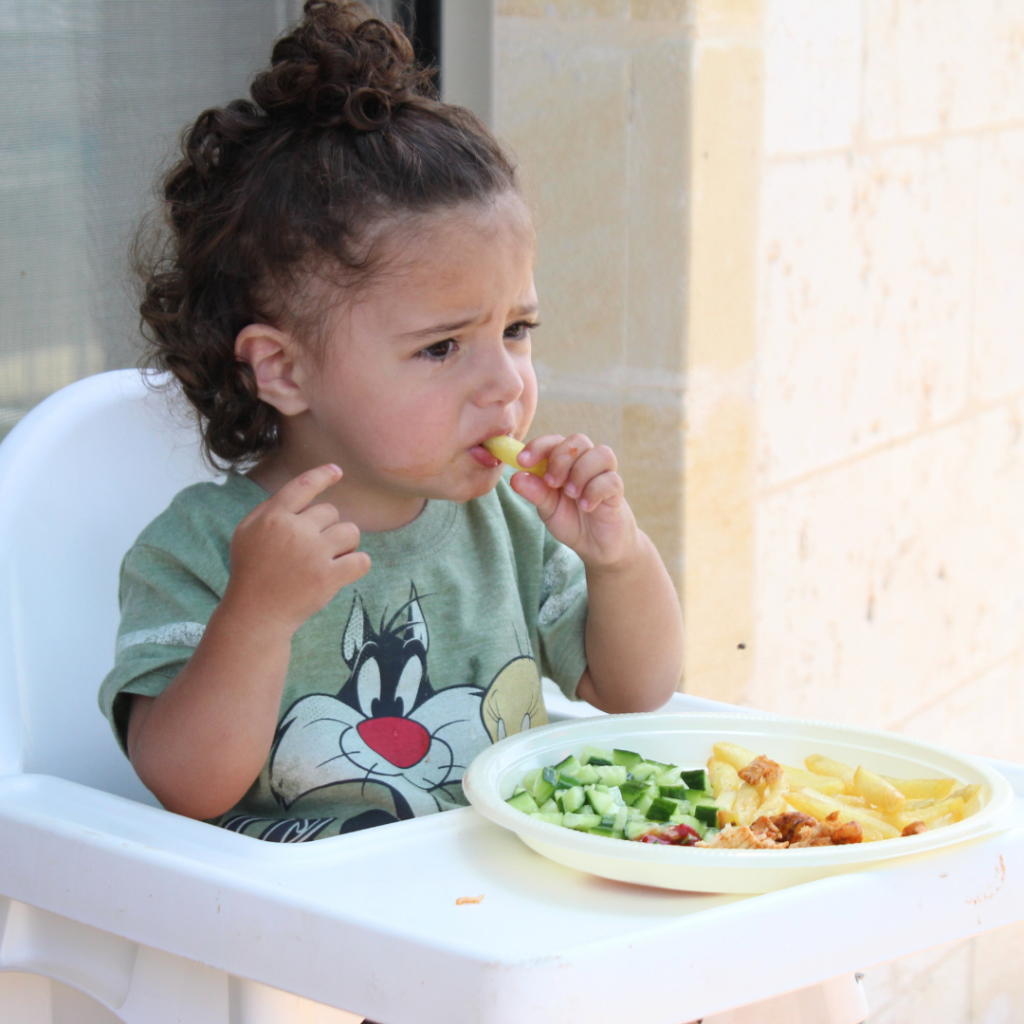
Whether you choose to continue breastfeeding or transition to a milk or milk alternative, the maximum milk intake for toddlers is 16oz per day. This means that as you approach 12 months old, you need to be thinking about how much milk they’re consuming and how you’d like to decrease that.
Too much cow’s milk in toddlerhood can cause issues with iron absorption, and can also exacerbate picky eating behavior. If your toddler is too full on cow’s milk, or a milk alternative, they will have little to no interest in eating table foods, or in trying out any new foods. Keep this in mind and be prepared to continue offering solids according to a feeding schedule in toddlerhood.
If you’re looking for guidance on this transition, check out our breast and bottle weaning guide for everything you need to make this transition easier, plus tips on night weaning too!
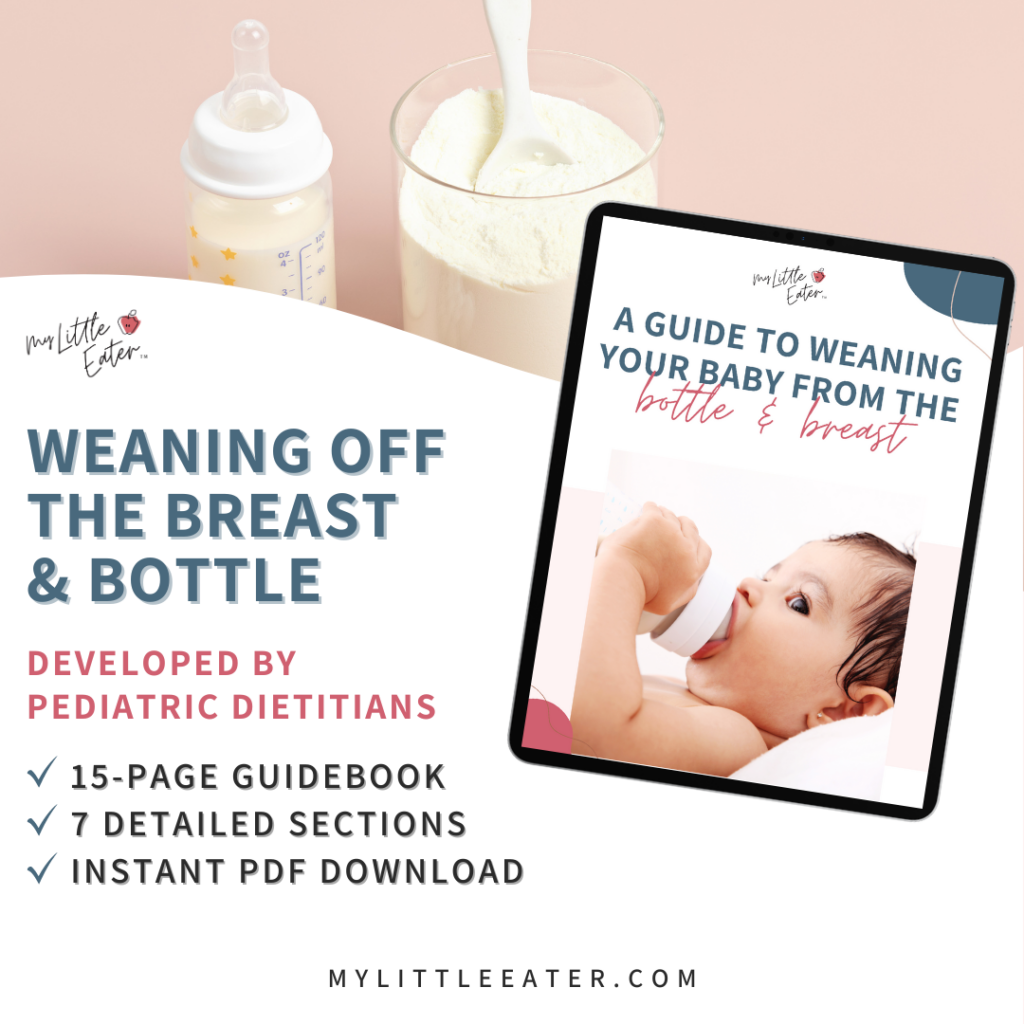
Starting solids feeding schedule: FAQs
Why are schedules so important for babies?
Without at least a general routine, you run the risk of overfeeding your baby, having a baby that refuses solids, or having a hangry baby that’s too frustrated to eat.
Offering food too often can result in the first two outcomes – overeating or having no appetite for solids, just milk. And not offering foods often enough results in a frustrated baby that is too hangry to eat.
Now, you may think that being extra hungry is a good thing – won’t they eat more solids that way? Not necessarily.
When they’re SO hungry, it’s difficult for them to concentrate or be patient enough to learn this new task. It takes a lot of effort, strength, and concentration to be able to hold themselves upright, reach for food, explore the food, and eventually eat it too. And if they’re too hungry or tired, they won’t be able to do those things successfully.
Another thing to consider that we speak about with toddlers frequently is that the goal is not to have a FULL baby all the time. Sometimes we push milk or food so frequently that your baby doesn’t have the option of having an empty stomach ever.
That feeling of fullness therefore becomes their new normal, and responding to every cry or emotion with milk or food becomes yours. Again, our post on feeding cues can help you decipher when hunger is truly the issue.
What if we’re not big on schedules and prefer to follow hunger cues?
That’s ok! As we mentioned, we really want you to be following hunger cues to adjust the schedule anyway, so really it’s taking both into account.
Think of the schedule as more of a guide to ensure your baby is getting the number of milk feedings and solid food meals they need each day, as opposed to a strict timeline for your day. It’s ok to adapt things to your baby and their hunger and fullness cues each day!
Should I offer solid foods morning or night?
We typically recommend adding in a morning solid food meal first, especially when you’re introducing top allergens. It’s important to be able to observe your baby for symptoms of a reaction for a few hours after eating the allergenic food. We don’t want them having dinner and then going right to bed for the night, for example.
With work schedules there’s no time in the morning for breakfast, when should we feed?
We completely understand how difficult this can be!
In these cases, we recommend choosing a meal during the day that works best for you and your schedules – and in some cases maybe that means a caregiver will be the one introducing solid foods. If that’s the case, we highly recommend our Baby Led Feeding online course. You can share access with your caregiver as well, plus we have a complete Caregiver Guide inside of it to help you prepare them for introducing solids!
If you have to serve solid meals in the evening during the week because of your work schedule, try not to offer any of the top allergens. Instead, we’d recommend using the weekends to introduce a new top allergen each week, with a second exposure. This way you can offer them early in the day so they aren’t going to sleep right after eating a highly allergenic food.
Pin it to save the schedules for later!
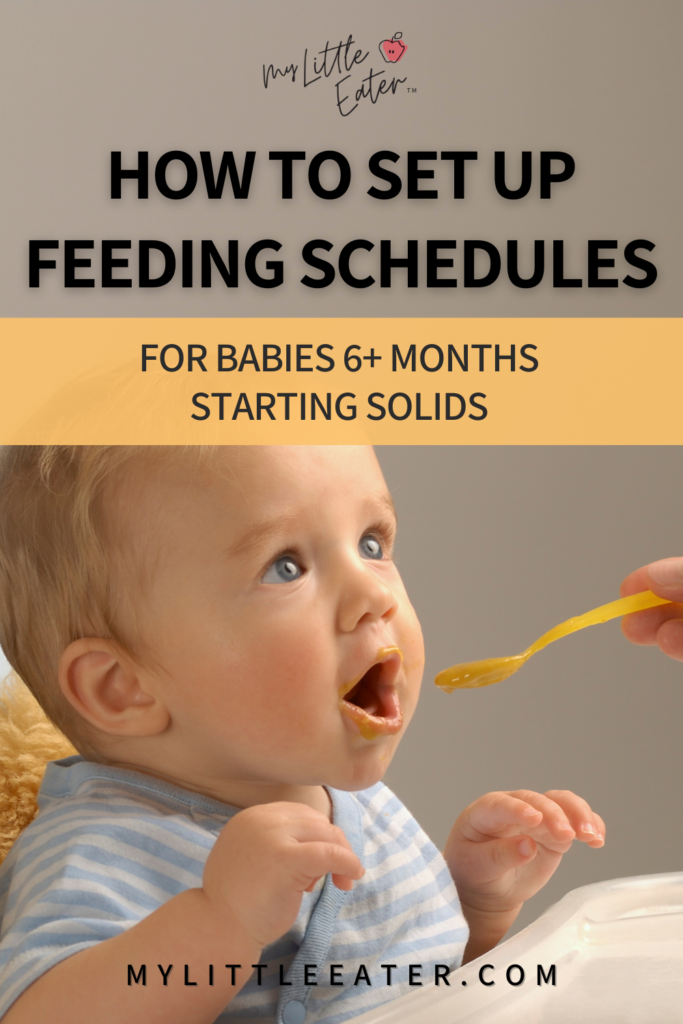

Edwena Kennedy, RD
Founder and lead Registered Pediatric Dietitian at My Little Eater Inc., creator of The Texture Timeline™, and mom of two picky-turned-adventurous eaters.

Edwena Kennedy, RD
Founder and lead Registered Pediatric Dietitian at My Little Eater Inc., creator of The Texture Timeline™, and mom of two picky-turned-adventurous eaters.
 toddler sale! 20% off toddler program with code Toddler20 at checkout
toddler sale! 20% off toddler program with code Toddler20 at checkout 




